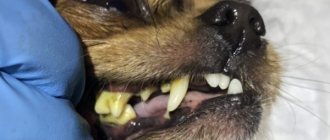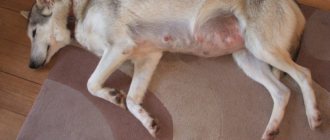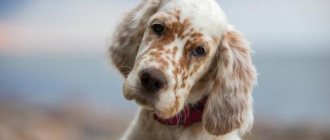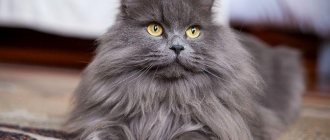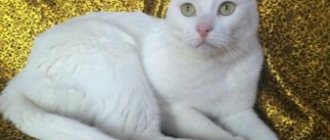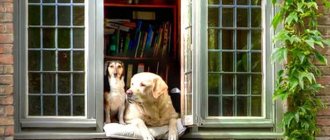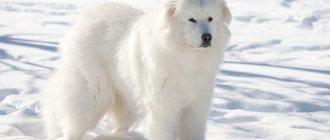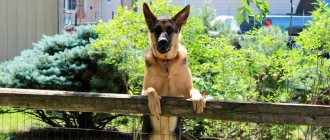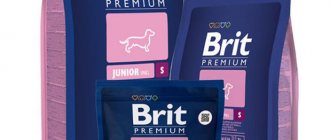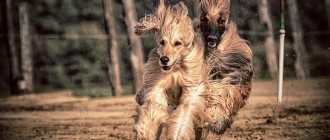Redhead dogs are bright, noticeable, and when exposed to the rays of the sun, they seem to become even redder. Because of their cheerful coloring, they seem good-natured, playful, and non-conflicting. Is it so? Or is this just a case where appearances are deceiving?
They look cunning, mischievous and cheerful. Under the sun's rays, the fur of such animals plays with all sorts of reddish shades. For you, we have collected the top 15 dog breeds with red hair, so that you can make your choice if you are planning to buy a pet, or just get to know these positive companions.
American Staffordshire Terrier
The Amstaff as a breed appeared a little over a hundred years ago, at the end of the 19th century. At that time, representatives of the breed were called pit bull terriers. Registered under its current name in 1936. For a long time it was not known anywhere except the USA. After it appeared in Europe, it was accepted with success, but the reputation of the breed was spoiled by stories about the aggression of its representatives. Some countries have banned keeping Amstaffs. Only thanks to the active actions of dog breeders, the breed was preserved, and in 1971 the International Canine Federation adopted a breed standard. Red is one of the main colors of this breed.
Amstaffs are short-haired and easy to care for. They are agile and strong, and really need daily physical activity (at least three hours). They combine the best qualities of a bulldog and terrier. They are brave and self-confident, extremely loyal to their owners.
Origin story
The history of Siberian huskies begins in ancient times, when the tribes that lived in the Far East of Russia, which are classified as the so-called “Okhotsk culture,” needed to move to new lands .
For this purpose, a strong, hardy and unpretentious sled dog breed was bred. From this breed, called the “Chukchi sled dog,” came not only Siberian huskies, but also Samoyeds and Malamutes.
The Chukotka sled dog is not recognized by the FCI and is currently considered rare, however, these dogs still continue to be bred in some settlements of Chukotka, where they are used for transporting goods, as well as hunting sea animals.
Husky, being descendants of representatives of this very ancient breed, along with strength, endurance and performance, inherited most of the colors inherent in the ancient Chukchi sledding breed, including red and its various variations.
At the beginning of the 20th century, when dogs from Chukotka were brought to Alaska, where red huskies, like dogs of all other possible colors, helped people deliver goods to remote settlements.
After the recognition of the breed, dogs of this color began to be used as companions and are now very popular among both ordinary owners and professional breeders.
Akita Inu
A very energetic and active breed. Dogs that have long been kept by the Japanese nobility. Belongs to the Spitz group. Akita Inus are large, can reach 75 cm in height and 50 kg in weight. The loyalty and devotion of the representatives of the breed is best told by the fact that the legendary dog Hachiko belonged to her. They don’t like to bark, but they are very talkative - they snort, grumble, and whine. They are incredibly curious by nature and stubborn to the same extent - they don’t like it when something doesn’t work out for them. They need to be trained from childhood, but you need to know that they are not very trainable. Therefore, if you are a novice dog breeder, there is a chance that this breed will not suit you.
Akita Inu considers himself a full member of the family in which he lives. Enjoys playing with children. It is more difficult for him with other animals - he needs to be socialized from a very early age.
The breed has a thick coat with a dense undercoat; it needs to be brushed every week, and during intense shedding - daily. They do not need washing often - about three times a year, but each time using dog shampoo.
What affects the color of an animal?
First of all, of course, it is genetics. The color of a companion depends on combinations of many genes. Some are responsible for the distribution of pigment throughout the hair, others for the saturation of dark shades, and others for the presence of color in general. Moreover, it should be taken into account that some genes may be in a suppressed state. For example, when mating two dogs with a light color, you can get a whole variety of shades, since a gene that was received from grandparents, but did not manifest itself, may come to the fore.
With the red color, everything is simpler: the gene that sets it is always dominant, therefore, when crossing two red dogs (even with admixtures of other genes), red puppies are always born. Due to this, there are many dog breeds for which red-colored coats are the only acceptable ones according to the standard.
Also, the color of the coat depends on the care and living conditions of the animal. For example, black dogs may develop a reddish tint when exposed to sunlight for a long time. In white pets, the appearance of red coloring is usually associated with diet. Carrots and beets can give this effect. Incorrect use of tinted shampoos can lead to color changes.
Irish Red Setter
Like other representatives of the “setter quartet”, it belongs to the family of cops. The peculiarity of the Irish Red is its rich, monochromatic coat color. He has a lean build, weighs up to 34 kg, and is up to 66 cm tall.
A breed originally intended for hunting. He “calculates” the game easily, sneaks after it like a cat, crouching to the ground so that the prey does not fly away. It can remain silent for a long time if it is hunting. Gets along well with the owner, does not like other dogs. He doesn't make a watchman; he's too sociable and friendly. A very smart breed.
Needs daily hour-long runs (better even more), loves to take long walks outside. If he is in the mood, he follows commands. The setter needs to be constantly trained, both physically and mentally. If this is not done, he will turn into a wayward and disobedient dog. At the same time, it is completely undesirable to use force, then the setter will be neither good-natured nor obedient. If a dog is playing with a child, it is best to keep an eye on them. When they see a bird or a rodent, the hunter in them wakes up.
Careful care is required. Firstly, regular brushing. Secondly, protection from dirt with a special overall, since too frequent washing harms the natural lubrication of the skin. In addition, it is necessary to regularly clean the dog’s ears (at least once a week), since otitis media often occurs in representatives of the breed. Eyes are cleaned as needed. They should be fed only with special food; in addition, setters drink a lot. You should have a supply of water while walking.
Dimensions, weight and other distinctive features
| Options | Description |
| Dimensions | Males - 53.5-60 cm Bitches - 50.5-56 cm |
| Weight | Males - 20.5-28 kg Bitches - 15.5-23 kg |
| Body Format | Rectangular, tending to square, in which the length of the body exceeds the height at the withers by no more than 3 cm. |
| Head | Not coarse, but not overly refined, with a moderately wide skull and a muzzle of medium volume, the length of which is equal to the skull. |
| Ears | Set quite high. Medium size, erect, triangular with slightly rounded tips. |
| Eyes | Brown, amber, golden, blue or with heterochromia, almond-shaped, moderately widely spaced. |
| Nose | Most often, it is brown or liver-colored. |
| Neck | Medium length, muscular and slightly arched, should not look too bulky nor thin and weak. |
| Rib cage | Moderately powerful and quite deep. |
| Limbs | The front ones are straight, parallel, not too wide apart. The hind legs have well-defined joint angles and moderately muscular thighs. |
| Tail | In a calm state it is lowered down, when excited it rises up and is held above the back in the form of a well-furred sickle. |
| Wool | Moderately long, but very thick and dense. The guard hair is coarser than the undercoat, which, moreover, can be of a different color, for example, cream or grayish. |
A red husky's tail should resemble a fox's and should never be curled into a ring..
Chow chow
One of the most difficult breeds. On the one hand, they need the attention of their owners, on the other hand, they do not need their approval. This is an intelligent, proud and strong-willed dog that should be trained from a very early age. Aggressive towards all other animals, unless she grew up with them from childhood.
The owner must respect his Chow Chow, otherwise he will become familiar with her mood swings and intemperance. Moreover, if the owner does not immediately explain to the dog who is in charge in the house, this place will be occupied by the chow-chow. If you train your Chow Chow correctly, it will not react aggressively to every new situation.
The thick coat of this handsome red cat needs to be brushed once or twice a week. You need to comb out all the hair that can be combed out, leaving nothing behind. Bathing more than once a month is not advisable; if there is dirt, you can use dry shampoo. The Chow Chow sheds heavily twice a year. The wool should not be cut under any circumstances.
It does not tolerate heat well; if the dog lives in the yard, you need to provide it with the opportunity to be in the shade and have a container with cool water nearby.
Popular names
There is a selection of nicknames that are traditionally called for red dogs; it is quite extensive and varied. Moreover, you can create a lot of your own variations for each name.
For boys:
- Admin
- Alan
- Apricot
- Alex
- Big Red
- Brick
- Valentine
- Gator
- George
- Gong
- Julius
- Dior
- Dorito
- Iron
- Cardinal
- Carmine
- Carnelian
- Carrot
- Quartz
- Ketchup
- Kidney
- Copper
- Copper
- Kremlin
- Crimson
- Kurri
- Lyon
- Lobster
- Maroon
- Merlos
- Nachos
- Nik-Nak
- October
- Orville
- Pumpkin
- Pepperoni
- Peach
- Pikachu
- Pyro
- Peachy
- Russet
- Grow
- Rugby
- Redding
- Robin
- Rojo
- Ronin
- Rory
- Reddy
- Radford
- Sullivan
- Sunrise
- Sunset
- Saffron
- Cinnamon
- Smokey
- Tiger
- Firefox
- Foxy;
- Freyherr
- Faeries
- Heinz
- Hazel
- Cheddar
- Chester
- Chitan
- Cheeto
- Eclipse
Airedale Terrier Alex the Magnificent
For girls:
- Azalea
- Berry
- Brandy
- Brick
- Burgundy
- Vinny
- Gilda
- Jinji
- Kamala
- Clementine
- Coral
- Cressida
- Lava
- Marcia
- Maruna
- Mabel
- Ora
- Oriana
- a penny
- Peoni
- Poppy
- Risi
- Ruby
- Ruzha
- Ruta
- Radina
- Savannah
- Salsa
- Sangria
- Sunny
- Sequoia
- Sandy
- Sienna
- Siesta
- Scarlet
- Solomiya
- Tawnee
- Fiesta
- Henna
- Cherry
- Chile
- Edana
- Amber
- Apple
- Yami
Dogs have a very developed desire to patronize and nurse. The story of the golden retriever Samson and the kitten Cleo is an example of this.
Boxer
The boxer appeared in Germany as a result of crossing a German shepherd and an English bulldog. This dog is very muscular, has a peculiar head structure and round eyes. They have great endurance and strength, thanks to which they serve in the police and security. Despite their intimidating appearance, they are very good-natured. Any change of mood is written on their face. Boxers have a strong nervous system. They are always calm at home, but active outside. Long walks do not frighten them, they love them and tolerate them well. He perceives strangers with caution. They are dexterous, brave and very strong.
Smooth-haired breeds
Smooth-haired dog breeds are “comfortable” friends whose care will not take much effort. This list includes fairly large pets, medium-sized animals, as well as small dogs that are ideal for keeping in an apartment. The selection from Lapkins.ru will allow you to familiarize yourself with the names and photographs of smooth-haired dog breeds, and then go to a page with a detailed description of each of them. Don't be surprised to see dogs you previously thought were fluffy listed as smooth-haired - some breeds have several varieties. For example, Fox Terrier, Alabai and White Swiss Shepherd.
Smooth-haired breeds have a number of undeniable advantages. Reflecting sunlight, the smooth wool fabric shines with a beautiful wet tint, which is especially noticeable in dark-colored animals - Dobermanns, Rottweilers, Cane Corsos. A dog with short hair always looks neat and well-groomed. Smooth-haired breeds have no undercoat or very little of it, and tangles do not appear. In addition, pets dry quickly after washing. Returning from a walk, you won’t have to painstakingly remove thorns and other gifts of nature from your pet’s “fur coat.”
However, it is still necessary to care for a smooth-haired dog - collect old hairs with a brush or mitten, and periodically bathe. Representatives of breeds planning to participate in exhibitions need a model haircut and professional care. As for shedding, although the hair volume will be less than that of furry dogs, the short, needle-like hairs can dig into clothing and furniture and be unpleasant to step on.
Small, smooth-haired dog breeds are the best pets for an apartment. The most popular indoor breeds are invariably the Toy Terrier and Chihuahua. The crumbs will require minimal time and material costs, for which they will fully reward the owner with affection and love.
Rhodesian Ridgeback
This breed has a wonderful character: they will support any idea of their owner, just to be with him, they are devoted to him and very affectionate. They play sports and play with equal pleasure, and if you decide to lie down on the sofa, they will climb next to you with great joy. Once he loves his owner, the Ridgeback is always devoted to him. If they see someone strange, they will drive him away with a loud bark. A dog’s docile nature does not mean that he does not need to be trained and educated.
How to choose?
You should only purchase a red husky puppy from a good nursery or from a breeder recommended by the kennel club. It is very important that the puppy has documents of origin and a veterinary passport.
Before buying a pet, you need to decide on its gender, coat color and quality..
Having arrived at the breeder's house or kennel, you should not rush to choose a baby, but carefully look around in order to be sure that adult dogs and puppies are kept in proper conditions, and only if everything is in order, you can go and look at the young animals.
Husky puppies should look well-fed, cheerful, active, friendly to people and at the same time be completely healthy.
It is not recommended to buy a baby who is afraid of people or shows aggression towards them, as serious problems may arise raising and training .
It is best to give preference to a medium-sized puppy with a playful, but at the same time balanced temperament.
Dachshund
The Dachshund is a nimble, curious and playful dog. She has a sharp mind and sometimes even a sense of humor. To subdue a dachshund, its owner will have to be patient and persistent. The Dachshund loves to play, but if it considers games inappropriate for itself, degrading its dignity, it will show its sharp teeth. Surprisingly, someone so small in size has a truly enormous ego. The owner must take this into account and not tease the animal unnecessarily.
Gastronomic nicknames
You can, for example, look around the kitchen. An undeniable source of inspiration!
For boys:
- Banana
- Damn Chick
- Mulled wine
- Yolk
- Kishmish
- Kompotic
- Cram
- Kumquat
- Sesame
- Lemonade
- Maize
- Mandarin
- Muffin
- Honey cake
- Nectar
- Melange
- Almond
- Myrtle
- Muscat
- Donut
- Gingerbread
- Ratatouille
- Salad
- Smoothie
- Sauce
- Tomato
- Fresh
- Candied fruit
- Saffron
- Szczec
- Egbert
- Eclair
Who is this delicious one?
Of course, Pomeranian Smoothie! For girls:
- Apricot
- Orange
- Mustard
- Ginger
- Ikrinka
- Toffee
- Caramel
- Cinnamon
- corn
- Dried apricots
- Turmeric
- Mango
- Mandarin duck
- Mead
- Lungwort
- Carrot
- Muesla
- Sea buckthorn
- Ola Dushka
- Papaya
- Paprika
- Pomi Dorra
- Pshenka
- Soybeans
- Spice
- Tira Misyus
- Pumpkin
- Persimmon
The butt is heavy, the stairs are high, but the little corgi Tira Misyus doesn’t give up so easily
Red Breton Griffon
This is a hunting dog that needs to be trained from childhood. Then she will have a strong-willed disposition and a calm character. The training required is complex and long. It should be fed correctly, monitoring the level of estrogen in the food. Attachment to their owners does not prevent them from being stubborn. The dog is a hunting dog and needs physical exercise in the fresh air. Ears are a dog’s weak point; you should carefully monitor their cleanliness and health.
Life expectancy and what diseases are they susceptible to?
On average, the life expectancy of red huskies is 12-15 years.
Most dogs of this breed are in good health, but some of its representatives may be susceptible to the following diseases:
- Degenerative myelopathy.
- Obesity.
- Entropion or inversion of the eyelid.
- Retinal atrophy.
- Glaucoma.
- Cataract.
- Dystrophy of the cornea of the eye.
- Cardiovascular diseases.
- Diseases of the genitourinary system.
- Respiratory diseases.
Eye diseases are more common in Huskies with blue eyes or heterochromia than in brown-eyed dogs of this breed.
Collie
The collie comes from Scotland, from the mountainous regions. This is a very sensitive breed and always responds to any manifestation of the owner’s attention. Collies get along well with children and are fun to play with and play sports with. They love their owners very much and are ready to do a lot for them. Collies are very easy to train and are smart and intelligent. However, it is better to conduct the first lesson with a dog trainer, especially if you are new to dog breeding.
Where to buy a puppy
The red Breton Basset is a rare and little-known breed, even in France. These dogs appeared in Russia recently, only in 2013. Mostly, puppies are bought for exhibitions and as companions, but there are already hunters who appreciate their working qualities. You can find out about breeders and planned litters on the website of the Club of Breeders and Owners of Red Breton Basset Hounds.
The motto of the French breed club is “Hunting First”. In France, breeders highly value Bretons and are reluctant to sell puppies abroad, especially as show dogs.
Price
The cost of rare breed puppies usually ranges from 30,000-70,000 rubles.
Hungarian Vizsla
This breed has an affectionate and cheerful disposition and is very hardy. Her character is balanced, and the Vizsla is an excellent hunting companion. If you raise a Vizsla correctly and treat it competently and attentively, then it will obey its owner and obey him. Because of her wonderful personality, she is the favorite of the whole family. Children over 4 years old play well with a well-mannered Vizsla, but it is not advisable to leave her unattended with younger children.
Advantages and disadvantages
pros:
- Beautiful and bright appearance.
- Friendly character.
- Lack of aggression towards people.
- Intelligence, intelligence and good learning ability.
- Love for children.
- Playful and cheerful disposition.
- Loyalty to the owner.
- Endurance and ability to adapt to different living conditions.
- Unpretentiousness in food and maintenance.
- It can live either in the courtyard of a private house or in an enclosure with a booth, or in an apartment.
Minuses:
- Excessive trusting of strangers.
- Hunting instincts, due to which the dog can be dangerous to other smaller pets.
- The need for increased physical and mental stress.
- Tendency to be self-willed and stubborn from time to time.
- They can howl or damage things in the absence of their owners.
- Predisposition to escape.
- They love to dig up the ground and can create a tunnel.
